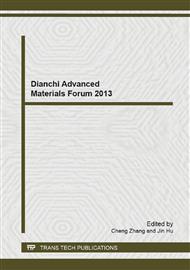p.41
p.45
p.50
p.56
p.61
p.66
p.70
p.75
p.80
Preparation Technology of ITO Composite Oxides Nanopowder
Abstract:
The technological parameters on synthesis rate of ITO nanometer by chemical coprecipitation were investigated. The effects of process parameters on synthesis rate of ITO nanometer powders were discussed by the range analysis of orthogonal experiment design. The dispersion features of ITO nanometer powder by ultrasonic dispersion or without were compared. The results show that the biggest factor that affects the powder synthesis rate is the pH at the titration end-point. Powder synthesis rate increases with the increase of pH value. When pH is 9, the powder synthesis rates are all above 90%. TEM images show that ITO nanometer powders are well dispersed without obviously agglomeration when anhydrous ethanol is used as dispersant. Particles have diversity of shapes, and the particle sizes distribute widely. After Ultrasonic physical dispersion, ITO nanopowders are well dispersed with no obviously agglomeration, narrow particle sizes of 20-30 nm and the approximation spherical particle morphology.
Info:
Periodical:
Pages:
61-65
Citation:
Online since:
November 2013
Authors:
Keywords:
Price:
Сopyright:
© 2014 Trans Tech Publications Ltd. All Rights Reserved
Share:
Citation:


